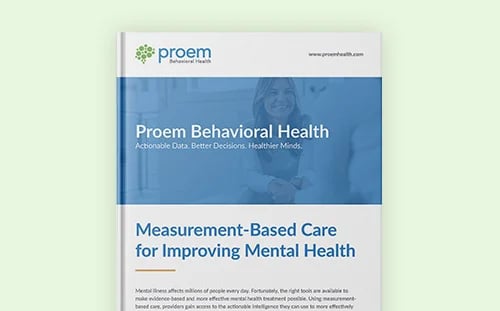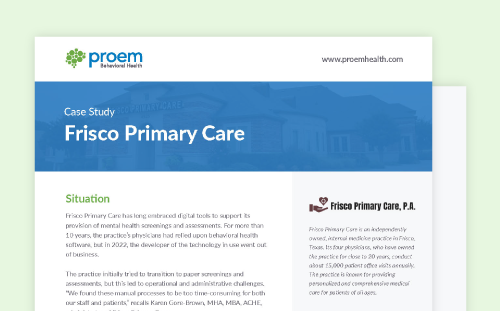The National Alliance on Mental Illness (NAMI) indicates that approximately 75% of lifetime mental health conditions begin by age 24. From the time symptoms appear until that individual is supported with appropriate interventions, the average gap in care is about 11 years in total. Mental health screening tools used early and correctly can play a key role in limiting this gap in care. Earlier identification of mental health disorders has been shown to lessen long-term disability and lead to overall improved clinical outcomes.
Mental Health Assessment Tools for Depression
According to the National Institute of Mental Health (NIMH), 8.3% of all U.S. adults (or 21 million people) had at least one major depressive episode in 2021. Further examination of the data reveals that the highest-risk populations for depression are women (10.3%) and and all individuals aged 18 to 29. NAMI and the United States Preventative Services Task Force (USPSTF) recommend early screening for major depressive disorder (MDD) as a result of this disease prevalence.
One of the most common mental health screening tools is the Patient Health Questionnaire ( PHQ9). It is a clinically valid, nine-item screening tool that is patient-administered or administered by a mental health clinician to measure for symptoms of Major Depressive Disorder (MDD).
The PHQ9 can be used at regular intervals along the treatment continuum to determine the improvement or stability of symptoms. PHQ9 was designed to screen for clinical depression, measure the severity of symptoms, and measure a patient's response to treatment. It tries to do so by asking patients to speak to how much they have been bothered by nine problems over the previous two weeks. Given how prevalent major depression is, this screening tool for clinical depression is useful for identifying patients who need further assessments.
One important note about the PHQ9: Even though it is intended to be used as a screening tool for depression only, the PHQ9 has increasingly been used as a diagnostic tool for mental illness in general. In fact, sometimes this mental health questionnaire is used in therapeutic decision-making. When relied upon to make a diagnosis, use of the PHQ9 and other screening tools can actually do more harm than good.
Proper Use of Mental Health Assessment Tools Can Lead to Accurate Diagnoses
For patients who screen positive for a mental health disorder, a more structured diagnostic interview may be warranted. For this, there are clinician-administered exams such as the Mini International Neuropsychiatric Interview (M.I.N.I.). This is a clinically validated structured diagnostic interview developed by psychiatrists for the purpose of diagnosing MDD and six of its subtypes, as well as other DSM-5 conditions. Identification of these different subtypes early in treatment is important to determine prognosis and approach to treatment. Translated in over 70 different languages, the M.I.N.I. is considered the most reliable diagnostic interview tool for depression and has been used in clinical trials and research in more than 100 countries.
Without the proper use of mental health screening tools, patients may not be able to articulate the symptoms they are experiencing. This is particularly true for adolescent populations. The effects of clinical depression on younger patients cannot be understated. For perspective, Medicaid programs have adopted the recommendations of the CDC and NAMI in requiring screening for mental health conditions in children. Primary care settings are ideal for performing proper screening for depression. in adolescents. Failure to screen may lead to delay in diagnosis and ultimately suboptimal timing of treatment.
Mental Health Screening Tools Can Save Lives
According to the Centers for Disease Control and Prevention (CDC), suicide is one of the leading causes of death in the U.S., with one suicide occurring every 11 minutes. Suicidal ideations and suicidal attempts represent a major contribution to premature mortality in our population, making interventions on this matter a public health imperative. One way to prioritize efforts toward suicide prevention is through leveraging screening tools and tracking scales such as the Sheehan – Suicidality Tracking Scale (S-STS).
The S-STS is a validated scale used in pediatric and adult populations. It has 14 core questions in addition to nine further contingent questions regarding suicidality. The questions can be administered by the clinician, self-administered by the patient or some combination of the two. Tools like the S-STS are important because they allow a clinician and patient to better monitor key features of suicidal behavior over time. Together with other screening tools for depression as well as clinical assessments performed by a trained mental health professional, the S-STS serves an essential role in the management of patients with suicidality.
With any mental health disorder, it's important to translate subjective patient data into objective information that a clinician and patient can track together. Screening tools and tracking scales permit an enhanced level of objective data collection. After all, how can you improve what you don’t measure?
How Effective Is Mental Health Screening in Your Organization?
Mental health screening is imperative to helping providers quickly and accurately identify those who need further evaluations for mental health disorders. That's why Proem Behavioral Health offers validated, reliable, and widely accepted clinical tools including the M.I.N.I. and S-STS. Our evidence-based behavioral health engine uses automation to help providers connect the data they gather to an evidence-based process workflow that can drive measurable improvements in patient outcomes.
Learn more about how our solution is helping make a difference for behavioral health providers and their patients, then schedule a demo to see firsthand how we can help you achieve even better patient outcomes.





.png)










